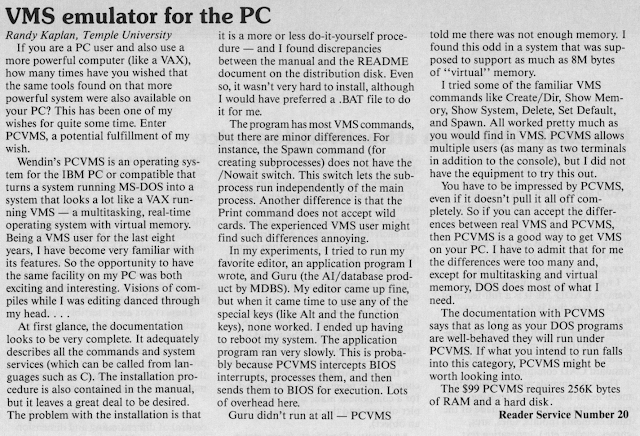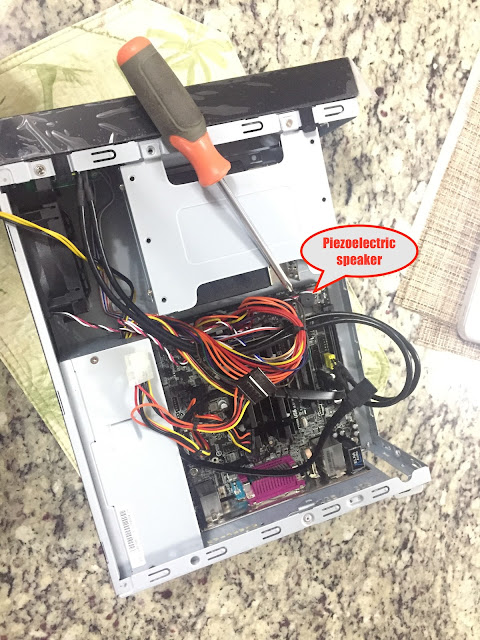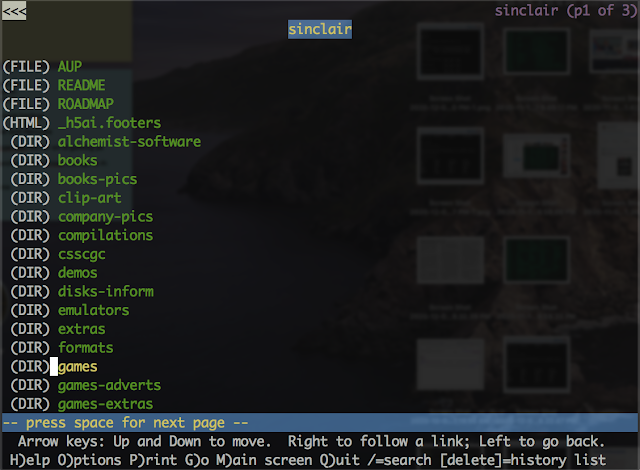Playing with computers since age 13, time to start documenting all the wonderful things and treasures I have discovered and developed - also a blog to serve as a time-saver by not having to reinvent the wheel.
Thursday, December 17, 2020
Raspberry Pi Wireless Wi-Fi TOR Anonymizer Gateway (Yet Another Post)
Friday, December 4, 2020
PCVMS - taking the aspirational DOS based VMS inspired multitasking environment for a spin
According to a smattering of information on the internet, there was once a computer software company called Wendin based in Cheney, WA. They launched a product called PCVMS "Personal Operating System" in 1985. It was distributed on a set of three 5.25" 360KB floppy diskettes. More history and juicy bits are in Bill's 2009 post in his "Personally Interesting Stuff" blog. I also found a public profile of Steve Jones at Linkedin, "Steve launched Wendin's Computer Systems Division in 1984, developing the XTC text editor, the PCVMS operating system ("a VAX/VMS operating system clone that ran on IBM PC/ATs), the PCUNIX (later called PCNX) operating system (a Unix clone that ran on IBM PC/ATs), Operating System Toolbox (an operating system toolkit that enabled software developers to create their own operating systems), and Wendin-DOS (an MS-DOS clone with OS/2-like screen groups and multitasking), among other products." The March 1997 issue of IEEE Software "New Product Reviews" contains a quick review of PCVMS written by Randy Kaplan of Temple University:
 |
R. Eckhouse, "New Product Reviews" in IEEE Software, vol. 4, no. 02, pp. 79-84, 1987.
doi: 10.1109/MS.1987.230374
keywords: {null}
url: https://doi.ieeecomputersociety.org/10.1109/MS.1987.230374 |
A trademark was apparently refused for "PCVMS" in 1986. It was described in the trademark application in 1985 as "MAIL ORDER COMPUTER PROGRAMS USED BY OWNERS OF PERSONAL COMPUTERS IN PERSONAL COMPUTERS AS OPERATING SYSTEMS PROGRAMS FOR THE GENERAL OPERATION OF SUCH PERSONAL COMPUTERS". In any case, a"VAX/VMS operating system clone that ran on IBM PC/ATs" is intriguing. Responses to my quick questions at the HECnet mailing list and comp.os.vms NNTP group indicate folks already played with PCVMS decades ago. However, the universal opinion seems to be PCVMS should be approached with tempered expectations.
I fired up a 86BOX instance running Caldera DR-DOS 7.03 on a 80486SX 25MHz PC and installed PCVMS 1.08 following the instructions in the PCVMS README file. On launching PCVMS, it asks for a username and password. Username "root" with empty password presented a welcome message and a "$" command prompt.
There is VMS-like help, one of the installed files even being HELPLIB.HLB like in DEC VAX VMS systems. On the other hand, the PCVMS user authentication system is straight off Unix, relying on a "passwd" file under "etc" directory under the boot drive. The touch of Unix probably has something to do with "PCNX UNIX-like environment; not just UNIX-like tools, but multi-processing under MS-DOS" which provided at, cat, cmp, cp, cron, date, df, echo, false, file, find, finger, getty, grep, group, grppswd, head, kill, line, logname, lpd, lpr, ls, mail, mkdir, mkgroup, mkuser, more, mv, news, nice, nohup, od, passwd, pr, ps, rev, rm, rmdir, rmgroup, rmuser, sh, sleep, strings, stty, tail, tee, test, time, touch, true, tty, uniq, wc, who, whodo, write.
By the way, I also briefly tried Wendin's "Wendin-DOS multitasking, multiuser MS-DOS replacement" which is publicly available, but it kept crashing with some sort of internal error in a rectangular box occupying the top third of the screen. This is another operating system that is my queue of things to explore further.
But, at this point, it appears for using "multi-user" features of PCVMS we need some sort of multiple hardware terminal connections with each then becoming a session. Something to be tried if and when I come back to this. A manual would be nice, but so far I have none.
Thursday, December 3, 2020
Command Line Torrent Client and Gopher Server on Raspberry Pi
One Raspberry Pi in my home lab has a 1TB USB external hard disk drive connected to it. I wanted to share some retrocomputing hobbyist-related stuff publicly in gopherspace. I also wanted a command-line torrent client to download retro public-domain stuff from archive.org and other places. Here are the pieces I ended up using.
GOPHER
I set up a gopher server on the Pi and opened up and forwarded TCP/IP Port 70 to it. I am able to reach the gopher server using a standard web-browser from the public internet using Floodgap Gopher-HTTP Gateway. Currently it has some ancient ZX Spectrum home microcomputer stuff. It is connection-rate limited using UFW, so slow down while visiting it to not be refused!
Floodgap also runs a great Veronica-2 Gopherspace Search engine.Here are the steps for quickly getting into Gopherspace:
Gopher server
pygopherd: PyGopherd is a modern Internet Gopher server written in Python and is maintained by John Goerzen. In addition to support for RFC 1436 Gopher and Gopher+, PyGopherd also supports HTTP and WAP (Wikipedia).
Gopher client (browser) - Text/Terminal
Good old Lynx terminal web client continues to support Gopher. It is available from standard package repositories for virtually every operating system in use.
Gopher Client (Browser) - Windows, Mac OS X
Little Gopher Client - works great, available for MacOS X, Linux and Windows.
Command-line bittorrent client
rtorrent works fine!
Thursday, November 26, 2020
BBC WORLD SERVICE: STREAMING THE NEWS CHANNEL I GREW UP WITH

By BBC News, Public Domain, Link
For as far back as I can remember, my father would come back from work in the evening, shower and grab a cup of tea and fire up a shortwave radio to tune into BBC World Service.
It is not as if I actively focused on Dad's radio. I went about whatever it was I did in those evening, with the voices from the radio floating around in the background.
As I grew older and left my parent's nest, it became apparent that pieces of that background voice noise had gotten embedded in my mind, without me being aware of it. Obviously, it got to a point where I had to find a way to tune into BBC World Service.
In the pandemic and politician stressed year 2020, BBC World News has done for me what no other audio or visual medium has done - calm me down. So, here are some ways to tune into BBC World News.
BBC World Service live official international audio internet stream URL: https://www.bbc.co.uk/sounds/play/live:bbc_world_service
Many more links to various BBC radio streams collected by Giles Booth: http://www.suppertime.co.uk/blogmywiki/2015/04/updated-list-of-bbc-network-radio-urls
Monday, November 9, 2020
Presidential Election 2020 Biden-Harris Victory over Trump-Pence: Anandabazar Patrika Coverage
Monday, November 2, 2020
Remembering the dot-matrix printer: Epson LQ-2500 24-pin dot matrix emulation on 86BOX running Windows 95
 |
| Example of simulated printout from Epson LQ-2500 24-pin impact dot-matrix printer |
I was thinking about the venerable dot matrix printers I grew up with. In an era WordPerfect for DOS ruled supreme, Panasonic, Epson and other printer manufacturers competed furiously, going from 9 pins in the print head to 24 and even to 48. Impact dot-matrix printing technology improved in leaps and bounds, eventually featuring "near letter quality" (NLQ) modes approaching laser printers. Epson's ESC/P standard was immensely popular, allowing software to select from various fonts and styles, even bitmap graphics and barcodes, built right into printers or optional cartridges. Those were great times for novice programmers to fool around with little filters in C to set the styles and pipe input to the printer. I could print AUTOEXEC.BAT in superscripted bolded italics by piping the DOS TYPE command through my filters written in Borland Turbo C, eventually out through LPT1! (The purpose of doing so eludes me now after a quarter century later from Windows 95.)
It recently occurred to me to look for emulators for those classic dot-matrix printers. However, it turned out to be a bit more difficult than I expected. Other than a commercial product called PRTWIN ("Epson matrix printer emulator under Windows") there was little out there on the internet for an emulator that would, for example, create a virtual parallel port (LPT1) for other programs to send print jobs to. I posted a question at - of all places - the QEMU mailing list, and was excited to hear from Will Senn about an emulator called 86BOX that includes the option of connecting an emulated ESC/P capable virtual printer to the LPT1 port of an emulated PC compatible machine.
 |
| 86BOX - Windows 95 Printer Test Page on emulated Epson LQ-2500 dot-matrix printer |
Turns out 86BOX is a fascinating PC emulator that I had not played with before. It emulates a numerous variety of PC architectures comprehensively and precisely at the motherboard and add-on card levels including BIOS and firmware. Of particular importance: among the hardware emulated by 86BOX is a generic Epson ESC/P standard printer that can be attached virtually to LPT1: parallel port!
Back in the day, my setup (actually my Dad's setup) was a Windows 95 PC with a Panasonic dot-matrix printer. I thus have a special bond with Windows 95, but getting Windows 95 to work on 86BOX with a functional LPT1: port proved to be a bit challenging. In the beginning, I could readily install Windows 95 OSR 2.5 on numerous motherboard, processor and peripheral combinations on 86BOX, but ended up every time with a dysfunctional parallel port (yellow exclamation in device manager) or no LPT1: port at all. Turns out the problem was, as usual, resource conflict with the sound card, and I had forgotten to allocate the sound card and parallel port IRQs specifically to the ISA bus instead of the default PCI (more details are below).
I nailed it eventually and now have a fully functional 86BOX PC with multimedia sound, networking and EPSON LQ-2500 dot-matrix printer. (This specific printer model is recommended for use with the ESC/P emulator built into 86BOX.)
The printer emulation works great including from WordPerfect Office 2000 and Microsoft Office 95. The LQ-2500 dot-matrix printer emulator happily generates PNG image files for printed pages in a "printer" subdirectory.
 |
| Printing from Microsoft Word 95 (Windows 95) to Simulated Epson LQ-2500 Dot Matrix Printer |
 |
| Printing from WordPerfect 9 (Windows 95) to Simulated Epson LQ-2500 Dot Matrix Printer |
Feeling more adventurous, I set up the 86BOX Windows 95 instance with pcap networking and shared the virtual printer on the network. Windows 95 successfully obtains an IP address from my router and connects to the internet. I can even see the Windows 95 shared LQ-2500 printer from other Windows 10 PCs on the network, but attempts to connect to it from Windows 10 have failed so far. Windows 10, unfortunately, throws up some hex error codes that I will have to do more research on (TBD). An initial web search seems to indicate NTLM version mismatch. Anyway, my working configuration of 86BOX running Windows 95 OSR 2.5 with simulated dot-matrix printing is:
- Machine Type: Socket 7-3V
- Machine: [i430FX] ASUS P/I-P54TP4XE
- CPU: Pentium OverDrive MMX 75
- Memory: 128 MB
- Video: [PCI] Diamond Stealth 64 VRAM (S3 Vision964)
- Mouse: Standard PS/2 Mouse
- Sound card: [ISA] Sound Blaster AWE32 (IRQ 5 has to be manually allocated to ISA in BIOS)
- MIDI Out Device: System MIDI
- Network adapter: [PCI] AMD PCnet-PCI II
- LPT1 Device: Generic ESC/P Dot-Matrix (IRQ 7 has to be manually allocated to ISA in BIOS)
- Hard disk: 1GB (2078 cylinders, 16 heads, 63 sectors = 1022 MB) on IDE Primary Master (Channel 0:0)
- 32x ATAPI CD-ROM on IDE Secondary Master (Channel 1:0)
- 3.5" 1.44 MB Floppy drive A:
- 5.25 1.2 MB Floppy drive B:
Here is the corresponding 86BOX configuration file:
As was usual for the Windows 95 era, I did go through the BIOS screens and fixed everything up to reflect the hardware. Once again, of special importance is the assignment of the IRQs used by the sound card and parallel port to ISA instead of PCI. Here are the BIOS screens:
While at it, of course I could not resist having some fun, while appreciating how remarkably close 86BOX comes to the "real" Windows 95 PC gaming experience.
 |
| Johnny Castaway Screensaver (Sierra, 1992) |
 |
| Fury 3 on Windows 95 |
 |
| Monster Truck Madness on Windows 95 |
 |
| Sid Meier's Civilization II |
Download:
If you wish, you can grab my entire Windows 95 86BOX virtual machine here.
Monday, October 19, 2020
Pandemic and Venus: March 2020
On March 5, 2020, an emergency was declared in my state of Maryland after COVID-19 was confirmed to have arrived with two people testing positive. By March 12, all schools and University of Maryland campuses had moved to continuing online after spring break. Emergency was escalated with the invocation of Maryland National Guard. By March 30, the number of cases had reached over 1000 and our governor issued a mandatory stay-at-home order. On the same day, Virginia and Washington DC also went into "lock-down" - a phrase that would eventually cease to surprise but which was terrifying when I first heard it.
Mid-April. Our bustling suburban city of 110,000 is a ghost town. Nothing moving in a deafening silence. A bit after dark. I step out and see a helicopter searchlight behind the trees. A pretty common sight - Medevac or police bird hovering, looking for something. I go back in thinking nothing of it.
Next night, around same time. The helicopter, searchlight on, still hovering at the exact same spot. Hmmm ... interesting, maybe the USAF is doing something at the nearby Andrews Air Force Base. Has happened before.
Night #3. Helicopter with light again. Beginnings of a doubt, but still shrugged it off.
Night #4 - Mental flags go up. A perfectly still helicopter at a geometrically precise location night after night at the same hour on the clock?
I fire up the sky-chart app. The hazy skies of the capital region had cleared so much that for the first time in my 23 years living here, I was looking at the dazzling evening star - Venus. I ran in and grabbed the kids. "Look at that - what do you think that is?"
HP T5740 Thin Client Retrocomputing Experiment: MS DOS 6.22, Windows 1.0, 2.0, 3.0, 3.11 and XP
Saturday, July 18, 2020
OpenVMS: Purge/Delete Expired Licenses and Clean Up LMF DB License Database
Saturday, July 4, 2020
Playing Audio Music (Big Ben Westminster Clock Chime) on Internal PC Speaker Connected to Motherboard Southbridge 8253 / 8254 PIT chip (Not Sound Card)
 |
| Motherboard with connected internal speaker |
 |
| PC internal Piezoelectric speaker » |
Thursday, May 21, 2020
Associate Wireless Adapter with a Wifi Access Point without assigning an IP address (for use by a Virtual Machine)
"SIOCSIFFLAGS: Operation not possible due to RF-kill"
Thursday, April 23, 2020
Installing and Executing DFU - the awesome ODS-2 Disk and File Utilities for OpenVMS VAX and Alpha
 |
| DFU for VMS Main Menu |
Introduction to DFU
The online help for DFU provides a great introduction to the tool:
"The ODS-2 Disk and File Utilities (DFU) is a collection of high performance utilities developed to perform routine maintenance and special purpose operations on disks, files and directories. The functionality offered by DFU is not or partly available through other DCL commands or VMS utilities.
DFU has the following functions:
- DEFRAGMENT : defragment individual files
- DELETE : delete files by file-id, and delete directory(trees) fast
- DIRECTORY functions
- COMPRESS , DUMP or RECOVER directories
- Search directories for files with multiple versions, alias files or empty directories
- INDEXF : analyze , defragment truncate and extend INDEXF.SYS
- REPORT : reports disk fragmentation
- SEARCH : search for files
- SET : set file attributes
- UNDELETE : recover deleted files
- VERIFY : analyze (and repair) the disk structure"
Installing DFU on OpenVMS VAX 7.3
The DFU tool for VAX servers running OpenVMS operating system is available free online for download. I installed it on MARIAH (31.70) - my real MicroVAX 3100-80.To download DFU VAX:
[localuser@linuxpc tmp]$ wget https://www.digiater.nl/openvms/freeware/v50/dfu027a/dec-vaxvms-dfu-v0207-a-1.pcsi
--2020-04-21 03:13:50-- https://www.digiater.nl/openvms/freeware/v50/dfu027a/dec-vaxvms-dfu-v0207-a-1.pcsi
Resolving www.digiater.nl (www.digiater.nl)... 185.92.71.114
Connecting to www.digiater.nl (www.digiater.nl)|185.92.71.114|:443... connected.
HTTP request sent, awaiting response... 200 OK
Length: 974848 (952K)
Saving to: ‘dec-vaxvms-dfu-v0207-a-1.pcsi’
100%[======================================>] 974,848 62.7KB/s in 13s
2020-04-21 03:14:04 (73.5 KB/s) - ‘dec-vaxvms-dfu-v0207-a-1.pcsi’ saved [974848/974848]
Then FTP the PCSI installer to the VAX:
[localuser@linuxpc tmp]$ ftp 10.42.2.5
Connected to 10.42.2.5 (10.42.2.5).
220 sanyalnet-vax.sanyalnet.lan FTP Server (Version 5.1) Ready.
Name (10.42.2.5:localuser): sanyal
331 Username sanyal requires a Password
Password:
230 User logged in.
Remote system type is VMS.
ftp> cd temp
250-CWD command successful.
250 New default directory is DUA1:[SANYAL.TEMP]
ftp> bin
200 TYPE set to IMAGE.
ftp> hash
Hash mark printing on (1024 bytes/hash mark).
ftp> put dec-vaxvms-dfu-v0207-a-1.pcsi
local: dec-vaxvms-dfu-v0207-a-1.pcsi remote: dec-vaxvms-dfu-v0207-a-1.pcsi
227 Entering Passive Mode (10,42,2,5,192,20)
150 Opening data connection for DUA1:[SANYAL.TEMP]DEC-VAXVMS-DFU-V0207-A-1.PCSI; (10.42.2.11,43577)
########################################################################################################################################################################################################################################################################################################################################################################################################################################################################################################################################################################################################################################################################################################################################################################################################################################################################################################################################################################################
226 Transfer complete.
974848 bytes sent in 0.49 secs (1987.70 Kbytes/sec)
ftp> bye
Then log into the VAX and install DFU.
DUA1:[SANYAL.TEMP] dir *.pcsi
Directory DUA1:[SANYAL.TEMP]
DEC-VAXVMS-DFU-V0207-A-1.PCSI;1
Total of 1 file.
DUA1:[SANYAL.TEMP] product install *
The following product has been selected:
DEC VAXVMS DFU V2.7-A Layered Product
Do you want to continue? [YES]
Configuration phase starting ...
You will be asked to choose options, if any, for each selected product and for
any products that may be installed to satisfy software dependency requirements.
DEC VAXVMS DFU V2.7-A: Disk and File Utilities for OpenVMS
Do you want the defaults for all options? [YES] NO
DEC VAXVMS VMS V7.3 [Installed]
* Configuration options for this referenced product cannot
* be changed now because the product is already installed.
* (You can use PRODUCT RECONFIGURE later to change options.)
Documentation in Text format [YES]
Documentation in PostScript format [YES]
Documentation in BookReader format [YES]
Documentation in HTML format [YES]
Do you want to review the options? [NO]
Execution phase starting ...
The following product will be installed to destination:
DEC VAXVMS DFU V2.7-A DISK$OPENVMS$7_3:[VMS$COMMON.]
Portion done: 0%...10%...20%...30%...40%...70%...80%...90%...100%
The following product has been installed:
DEC VAXVMS DFU V2.7-A Layered Product
DUA1:[SANYAL.TEMP]
Attempting to run DFU straightaway fails. We need the identifier DFU_ALLPRIV to be granted to the user.
DUA1:[SANYAL] dfu defrag vaxgames.sav
%DFU-E-NOPRIV, No privilege to perform this function (DFU_ALLPRIV not granted)
Proceed to grant the required identifier to the user.
DUA1:[SANYAL.TEMP] cd sys$system
SYS$SYSROOT:[SYSEXE] mc authorize
UAF>
UAF> grant/identifier DFU_ALLPRIV SANYAL
%UAF-I-GRANTMSG, identifier DFU_ALLPRIV granted to SANYAL
UAF> exit
%UAF-I-NOMODS, no modifications made to system authorization file
%UAF-I-NAFNOMODS, no modifications made to network proxy database
%UAF-I-RDBDONEMSG, rights database modified
LOGOUT and log back in. Once the identifier is granted, DFU can be used.
$ set proc/priv=all
DUA1:[SANYAL] dfu defrag vaxgames.sav
┌──────────────────────────< DFU V2.7-A (Freeware) >───────────────────────────┐
│%DFU-I-DEFRAG, Start defragmenting file(s) ... │
│%DFU-S-MOVED, File DUA1:[SANYAL]VAXGAMES.SAV;2 defragmented │
│ │
│%DFU-I-READY, DEFRAG command ready │
│ │
│ │
│ │
│ │
│ │
│ │
│ │
│ │
│ │
│ │
│ │
│ │
│ │
│ │
├──────────────────────────────────Statistics──────────────────────────────────┤
│ │
│ │
└──────────────────────────────────────────────────────────────────────────────┘
DUA1:[SANYAL] dfu search dua2 /version_num=min=500
┌──────────────────────────< DFU V2.7-A (Freeware) >───────────────────────────┐
│%DFU-I-SEARCH, Start search on DUA2: (QCOCAL$DUA2:) │
│ │
│QCOCAL$DUA2:[FAL$SERVER]INTRUSIONS.TXT;880 19/21 │
│ │
│%DFU-I-EOF, End of file INDEXF.SYS, Primary headers : 3491 │
│ │
│%DFU-S-FND , Files found : 1, Size : 19/21 │
│ │
│ │
│ │
│ │
│ │
│ │
│ │
│ │
│ │
│ │
│ │
├──────────────────────────────────Statistics──────────────────────────────────┤
│ Progress : | 100% | │
│ Status : READY │
└──────────────────────────────────────────────────────────────────────────────┘
Installing DFU on OpenVMS Alpha 8.3
Installing DFU on OpenVMS/Alpha is just like installing on VAX VMS. I installed it on RAPTOR (31.18) - an AlphaServer ES40 833 MHz running OpenVMS Alpha 8.3:
$ SHOW CPU
System: RAPTOR, AlphaServer ES40 833 MHz
CPU ownership sets:
Active 0
Configure 0
CPU state sets:
Potential 0
Autostart 0
Powered Down None
Not Present None
Failover None
$
First, download the OpenVMS/Alpha edition of DFU on a local Linux machine:
[localuser@linuxpc ~]$ wget https://www.digiater.nl/openvms/freeware/v70/dfu/dec-axpvms-dfu-v0301-1-1.pcsi
--2020-04-22 01:45:43-- https://www.digiater.nl/openvms/freeware/v70/dfu/dec-axpvms-dfu-v0301-1-1.pcsi
Resolving www.digiater.nl (www.digiater.nl)... 185.92.71.114
Connecting to www.digiater.nl (www.digiater.nl)|185.92.71.114|:443... connected.
HTTP request sent, awaiting response... 200 OK
Length: 1392640 (1.3M)
Saving to: ‘dec-axpvms-dfu-v0301-1-1.pcsi.1’
100%[======================================>] 1,392,640 138KB/s in 13s
2020-04-22 01:45:57 (104 KB/s) - ‘dec-axpvms-dfu-v0301-1-1.pcsi.1’ saved [1392640/1392640]
Then FTP the DFU PCSI installer to the Alphaserver:
[localuser@linuxpc ~]$ ls *pcsi
dec-axpvms-dfu-v0301-1-1.pcsi dec-vaxvms-dfu-v0207-a-1.pcsi
[localuser@linuxpc ~]$ ftp 10.42.2.12
Connected to 10.42.2.12 (10.42.2.12).
220 raptor.sanyalnet.lan FTP Server (Version 5.6) Ready.
Name (10.42.2.12:localuser): sanyal
331 Username sanyal requires a Password
Password:
230 User logged in.
Remote system type is VMS.
ftp> bin
200 TYPE set to IMAGE.
ftp> hash
Hash mark printing on (1024 bytes/hash mark).
ftp> put dec-axpvms-dfu-v0301-1-1.pcsi
local: dec-axpvms-dfu-v0301-1-1.pcsi remote: dec-axpvms-dfu-v0301-1-1.pcsi
227 Entering Passive Mode (10,42,2,12,192,16)
150 Opening data connection for SYS$SYSDEVICE:[SANYAL]dec-axpvms-dfu-v0301-1-1.pcsi; (10.42.2.11,37666)
################################################################################################################################################################################################################################################################################################################################################################################################################################################################################################################################################################################################################################################################################################################################################################################################################################################################################################################################################################################################################################################################################################################################################################################################################################################################################################################################################################################################################
226 Transfer complete.
1392640 bytes sent in 0.241 secs (5784.11 Kbytes/sec)
ftp> bye
221 Goodbye.
Invoke the PCSI installer as usual:
$ DIR *.PCSI
Directory SYS$SYSDEVICE:[SANYAL]
dec-axpvms-dfu-v0301-1-1.pcsi;1
Total of 1 file.
$
$ PRODUCT INSTALL *
%PCSI-I-CANNOTVAL, cannot validate RAPTOR$DKA0:[SANYAL]dec-axpvms-dfu-v0301-1-1.
pcsi;1
-PCSI-I-NOTSIGNED, product kit is not signed and therefore has no manifest file
The following product has been selected:
DEC AXPVMS DFU V3.1-1 Layered Product
Do you want to continue? [YES]
Configuration phase starting ...
You will be asked to choose options, if any, for each selected product and for
any products that may be installed to satisfy software dependency requirements.
DEC AXPVMS DFU V3.1-1: Disk and File Utilities for OpenVMS Alpha
Do you want the defaults for all options? [YES] NO
DEC AXPVMS VMS V8.3 [Installed]
* Configuration options for this referenced product cannot
* be changed now because the product is already installed.
* (You can use PRODUCT RECONFIGURE later to change options.)
Documentation in Text format [YES]
Documentation in PostScript format [YES] NO
Documentation in Adobe (R) PDF format [YES] NO
Documentation in HTML format [YES] NO
Do you want to review the options? [NO]
Execution phase starting ...
The following product will be installed to destination:
DEC AXPVMS DFU V3.1-1 DISK$ALPHASYS:[VMS$COMMON.]
Portion done: 0%...10%...20%...60%...70%...100%
The following product has been installed:
DEC AXPVMS DFU V3.1-1 Layered Product
$
$ DIR SYS$SYSTEM:DFU.EXE
Directory SYS$COMMON:[SYSEXE]
DFU.EXE;1
Total of 1 file.
Define a symbol to make running DFU easier (this same symbol can be defined in SYS$MANAGER:SYLOGIN_VMS.COM too), and away we go running the great tool.
$ DFU :== "$SYS$SYSTEM:DFU.EXE"
$ DFU HELP
┌─────────────────────────────< DFU Help Screen >──────────────────────────────┐
│ │
│DFU │
│ │
│ │
│ The ODS-2 Disk and File Utilities is a high performance utility │
│ developed to perform routine maintenance and special purpose operations │
│ on disks, files and directories. The functionality offered by DFU │
│ is not or partly available through other DCL commands or VMS utilities. │
│ │
│ DFU has the following functions: │
│ │
│ o DEFRAGMENT : defragment individual files │
│ o DELETE : delete files by file-id, and delete directory(trees) fast │
│ o DIRECTORY functions │
│ : COMPRESS , DUMP or RECOVER directories │
│ : search directories for files with multiple versions , │
│ alias files , or empty directories │
│ o INDEXF : analyze , defragment truncate and extend INDEXF.SYS │
│ o REPORT : reports disk fragmentation │
│ │
│Press RETURN to continue... │
└──────────────────────────────────────────────────────────────────────────────┘
┌─────────────────────────────< DFU Help Screen >──────────────────────────────┐
│ o SEARCH : search for files │
│ o SET : set file attributes │
│ o UNDELETE : recover deleted files │
│ o VERIFY : analyze (and repair) the disk structure │
│ │
│ │
│ │
│ Additional information available: │
│ │
│ New_features Restrictions DEFRAG DELETE │
│ DIRECTORY EXIT HELP INDEXF REPORT Screen_Management │
│ SEARCH SET SPAWN UNDELETE VERIFY │
│ │
│DFU Subtopic? │
│ │
│ │
│ │
│ │
│ │
│ │
│ │
└──────────────────────────────────────────────────────────────────────────────┘
$ DFU
┌────────────────────────────────< DFU V3.1-1 >────────────────────────────────┐
│ │
│ Disk and File Utilities for OpenVMS V3.1-1 │
│ DFU functions are : │
│ │
│ DEFRAGMENT : Defragment files │
│ DELETE : Delete files by File-ID; delete directory (trees) │
│ DIRECTORY : Manipulate directories │
│ INDEXF : Modify /View INDEXF.SYS │
│ REPORT : Generate a complete disk report │
│ SEARCH : Fast file search │
│ SET : Modify file attributes │
│ UNDELETE : Recover deleted files │
│ VERIFY : Check and repair disk structure │
│ │
│ │
│ │
│ │
│ │
├──────────────────────────────────Statistics──────────────────────────────────┤
│ │
│ │
└──────────────────────────────────────────────────────────────────────────────┘
DFU> exit
$
$ DFU SEARCH DKA0 /VERSION=MINIMUM=2000
┌────────────────────────────────< DFU V3.1-1 >────────────────────────────────┐
│%DFU-I-SEARCH, Start search on DKA0: (RAPTOR$DKA0:) │
│ │
│RAPTOR$DKA0:[SYS0.NML$SERVER]NETSERVER.LOG;28983 2/16 │
│RAPTOR$DKA0:[SYS0.TCPIP$SMTP]TCPIP$SMTP_RECV_RUN.LOG;32767 │
│ 2/16 │
│RAPTOR$DKA0:[SYS0.NML$SERVER]NETSERVER.LOG;28984 2/16 │
│RAPTOR$DKA0:[SYS0.TCPIP$NTP]TCPIP$NTP.DRIFT;17209 1/16 │
│RAPTOR$DKA0:[SYS0.NML$SERVER]NETSERVER.LOG;28981 2/16 │
│RAPTOR$DKA0:[SYS0.NML$SERVER]NETSERVER.LOG;28982 2/16 │
│RAPTOR$DKA0:[SYS0.NML$SERVER]NETSERVER.LOG;28980 2/16 │
│ │
│%DFU-I-EOF, End of file INDEXF.SYS, Primary headers : 11455 │
│ │
│%DFU-S-FND , Files found : 7, Size : 13/112 │
│ │
│ │
│ │
│ │
├──────────────────────────────────Statistics──────────────────────────────────┤
│ Progress : | 100% | │
│ Status : READY │
└──────────────────────────────────────────────────────────────────────────────┘
$
$ DFU DEFRAG RAPTOR$DKA0:[SYS0.NML$SERVER]NETSERVER.LOG
┌────────────────────────────────< DFU V3.1-1 >────────────────────────────────┐
│%DFU-I-DEFRAG, Start defragmenting file(s) ... │
│%DFU-S-MOVED, File RAPTOR$DKA0:[SYS0.NML$SERVER]NETSERVER.LOG;28984 defragment│
│ed │
│ │
│%DFU-I-READY, DEFRAG command ready │
│ │
│ │
│ │
│ │
│ │
│ │
│ │
│ │
│ │
│ │
│ │
│ │
│ │
├──────────────────────────────────Statistics──────────────────────────────────┤
│ │
│ │
└──────────────────────────────────────────────────────────────────────────────┘
$


















